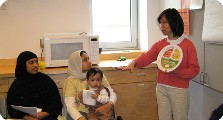Department of Health
Reaching New American Populations
Health Department reaching out to New Americans.
This article is 10 years old. It was published on October 1, 2014.

Now You're Speaking My Language
Anyone one who lives in St.
Louis knows that our population is diverse. While nearly half of the City's population is
African-American, the City also has a large number of immigrants and
refugees. In the mid-1990s, St.
Louis was designated as a resettlement area for
refugees from the then-current conflict in Bosnia-Herzegovina. Today it is estimated that there are
approximately 70,000 Bosnians who now call St.
Louis home. In the years since the first Bosnian refugees arrived, they have been
joined by refugees from unrest in countries around the world including Vietnam,
Somalia, Bhutan, Afghanistan, Laos and a number of other countries. In addition to the many refugees, St.
Louis has become home to immigrants who have come
from
One major challenge is the language barrier. Health information is universal; if there is a general health threat, everyone needs to know. However, limitations in communicating in the many languages spoken in St. Louis today make sharing those threats challenging. The Health Department has been working on a number of efforts over the years to meet that challenge.
In the past, the Department of Health put some initiatives in place to help it to reach the immigrant and refugee or "New American" populations. These efforts included a welcome sign where visitors could identify the language they spoke and be provided the interpretation services they needed at no cost. Interpretation was provided through the Language Line using telephones. Through the Language Line's ability to interpret in over 200 languages, the City's capacity to communicate with residents who had limited English-language skills was greatly enhanced. Since Hispanics, Bosnians, and Vietnamese have the largest representation, efforts were made to ensure a variety of translated materials were available in those languages. Additionally, staff members who were able to converse in those three languages were on-hand at the Health Department. The Department also partnered with the International Institute - St. Louis to fill other needs as they arose.
As another facet of our efforts to enhance the quality of the services provided and extend the reach of our health messages, the department is working on a new endeavor. "Reaching a variety of audiences has always been among our high standards here at the DOH. As we grow, however, we now have the additional charge of documenting how our information around public health issues and public health functions is reaching the different facets of the St. Louis community," states A.J. Pupillo, a Public Health Program Representative in the Bureau of Communicable Disease Control. Pupillo has been charged with identifying current staff members who speak other languages. These staff member will have the opportunity to participate in improving customer interaction via translation, interpretation and other communication-based enhancements. So far, the Health Department had identified a capacity to personally converse in 10 languages including Spanish, German, French, Kinyarwanda, Kirundi, Swahili, Vietnamese, Hindi, Nepali, and Russian, as well as American Sign Language. We hope the addition of this endeavor will further enhance the services we provide to St. Louis' diverse population.
Do you speak another language? Would you be interested in helping out with this new endeavor? If so, please contact A.J. Pupillo at PupilloA@stlouis-mo.gov or 314/657-1547.
-
Department:
Department of Health
-
Topic:
Health